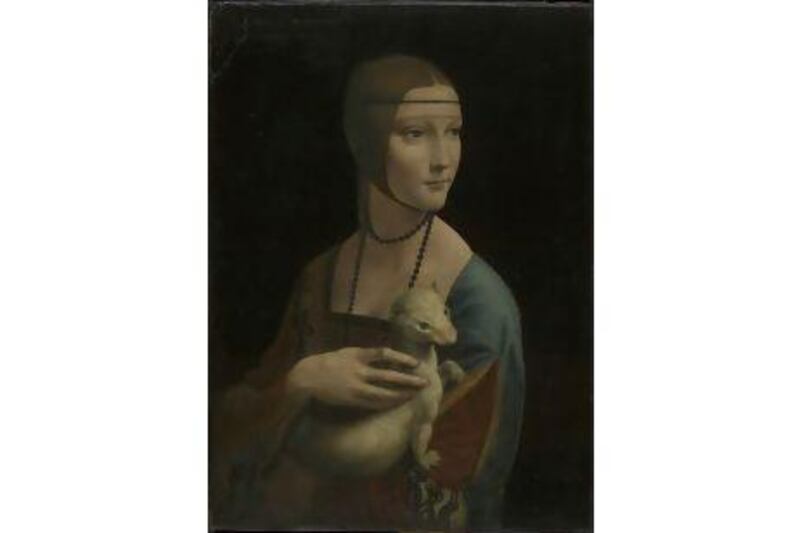An unparalleled number of advance tickets have been sold to what's already been called London's biggest art show of the year, a Leonardo da Vinci exhibition that opened on Tuesday at the National Gallery on Trafalgar Square. Of the 15 or 16 surviving paintings by the ultimate Renaissance artist (the exact figure is disputed) nine have been brought together for Painter at the Court of Milan; even Leonardo himself would never have seen some of these finished works side by side.
Insurance for the exhibition has been reported to have a value of a cool £1.5 billion (Dh8.9bn) and emotions were running high at a preview on Tuesday, with the curator Luke Syson close to tears at an introductory speech.
Art: The National looks
Exhibitions, reviews, news, features and all things art
[ Art ]
"People have talked about this as an unprecedented opportunity," said Syson, who has been working on the exhibition for five years. "It is an unprecedented opportunity. It probably won't happen like this again, and so it's very moving, the thought that we might be able to understand Leonardo better thinking about this extraordinary group of works together."
Nicholas Penny, the National Gallery's director, said that the one downside of the show was that it leaves him "with the problem of ever doing anything this magnificent ever again".
While da Vinci's most famous painting, the Mona Lisa, remains in its bulletproof case in Paris, the new display gathers together some of his most breathtaking works, including Christ as Salvator Mundi, the first rediscovered da Vinci in 100 years, exhibited here for the first time and two versions of The Virgin of the Rocks, one from the Louvre and one from the National Gallery's own collection, which have never before been exhibited in the same room. The show focuses on the middle of da Vinci's career, when he worked for Ludovico Sforza (later the Duke of Milan), and despite the fact that he originally applied to work for Ludovico as an engineer, it sidelines his science to focus on art.
Little is said of the recent theory that da Vinci may have been of Arab descent (as suggested by the fingerprint decoded in 2007 and the fact that his peasant mother, unmarried to his father, is thought to have been a slave from Istanbul), although a decorative engraving of knots arranged in a circle that is included in the show has the swirling, intricate geometry of Islamic design. Inscribed in the centre of the pattern are the words "Academia Leonardi Vinci", and exhibition materials suggest it can be seen as the first surviving example of abstract art.
It's clear that Leonardo had at least some input into that design, but verifying his work is an awkward business, as shown by the disputes still raging about the authenticity of many paintings. The Salvator Mundi was only recently authenticated after it was painted over, damaged, and sold for just £45 (Dh264) in 1958. Looking at it now, expertly restored, it's clear that it's the work of a master. The figure is rendered in exquisite sfumato with intricate wrinkles and folds in his clothes, a ghostly quality to the faded face and a delicately painted crystal globe in one hand. The technology did not exist in da Vinci's time to create such a sphere, so it is assumed to be a work of the artist's considerable imagination.
In an adjoining room hang the two Virgin of the Rocks, different in colouring and composition but still unmistakably variations on the same idea. While both show Mary surrounded by Saint John, Jesus and an angel, the Louvre's painting is both darker and warmer, with the angel looking out of the picture with the hint of a smile. The National Gallery's painting has recently undergone another thorough restoration, and its blues, in particular, seem to leap from the canvas. This time, though, the angel's gaze is turned inwards, and the feeling is more remote. It too, was only recently authenticated.
Although there are only nine full-scale da Vinci works on show at the National Gallery, the exhibition is full of delights, including sketches, paintings by da Vinci's contemporaries and anatomical diagrams. The Lady with an Ermine captures both a specific liveliness and a timeless beauty; a bright, clear, life-size copy of The Last Supper, made around 25 years after the original, shows details you can't see on the mural in Milan; and a painting of an elderly Saint Jerome beating himself with a rock is agonisingly lifelike.
It's clear that the artist considered his work to be crucially important: he is quoted as saying that "the divinity which is the science of painting transmutes the painter's mind in to a resemblance of the divine mind".With works in progress set alongside finished masterpieces, it's a privilege to be able to get a glimpse inside that mind and marvel at the way it operates.
Leonardo da Vinci: Painter at the Court of Milan, the National Gallery until February 5. To view a collection of da Vinci's inventions, manuscripts and art, visit the Burjuman Mall in Dubai. Located in the observatory beside the Virgin Megastore, daily from 10am-10pm until December 5





